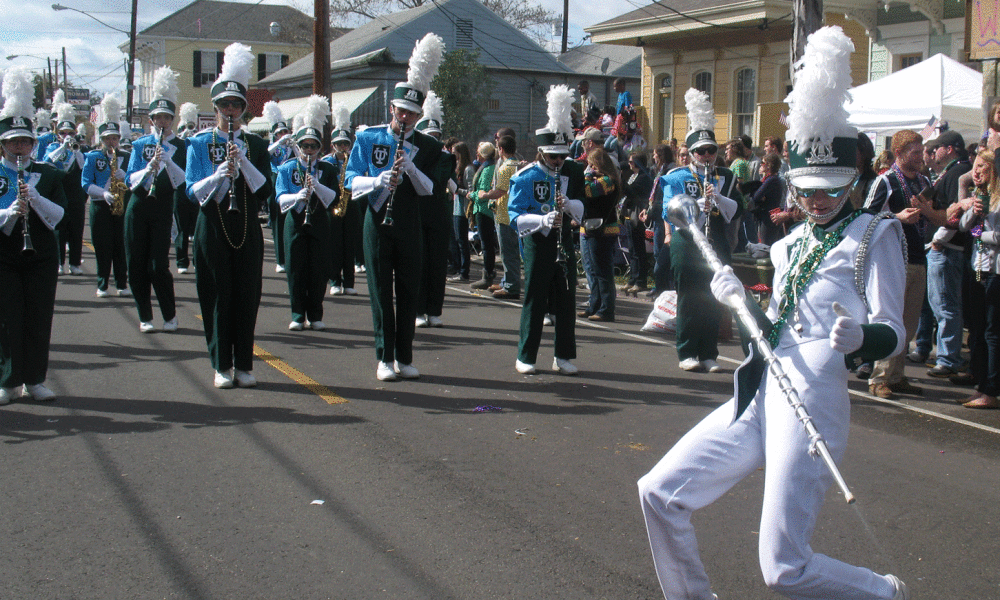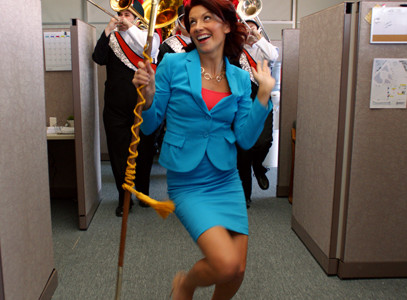For the majority of Americans, the Mardi Gras experience in New Orleans is one like no other. For marching bands that participate, it is an epic annual tradition.
Photo by Zack Smith, Tulane University Marching Band staff
So many beads. They’re everywhere. Purple ones hanging from the trees. Gold ones in the gutters. How did the green beads get up on that house along the parade route? So many beads. Beads on the sidewalk. Beads on the street.
“The worst part is slipping on the beads during a dance,” exclaims Elizabeth King, a drum major with the Tulane University Marching Band in New Orleans. “The roads become treacherous due to all the beads, bags, horses and other items on top of all the potholes!”
Not that King is complaining. Indeed, marching in a New Orleans Mardi Gras parade is one of the best events of the year for her and for the Tulane marching band and all the marching bands—they are legion—that have the honor of participating.
“It’s not just a fun parade in a magical kingdom,” King says. “It’s an outrageous parade and a time for locals to have a good time and catch some beads.”
So many beads.
Fun, Fun, Fun
Mind you—Mardi Gras is not just one parade, not just one event, not just one thing. New Orleans is a riotous cavalcade of parades and festivities that begin in early January each year and continue on to “Fat Tuesday.” That’s the last day of the Carnival season, falling on the day before Ash Wednesday, the first day of Lent.
There are dozens of parades in dozens of neighborhoods. Some are huge. Some are small. Some are for kids and families. Some aren’t. There are quite a lot of logistics working with the city and the police and the participants and the residents and all the rest. The thing is—the fun always trumps the work.
“Mardi Gras has always been a special time of year,” says Bobbi Mannino, a fifth-generation New Orleanian and director of public relations and marketing for Compucast, the web developer for www.MardiGrasNewOrleans.com.
New Orleans Mayor Mitchell J. Landrieu recently stated on the website: “Spectacular parades with beautiful and creative floats begin parading two weekends prior to Mardi Gras day. Our private carnival clubs, called krewes, take on royalty status and throw beads, doubloons and toys to all our parade-goers. Visitors quickly learn to say, ‘Throw me something, mister!’”
According to Mannino, “You need to bring a large bag, so that you can haul away all the stuff you are going to catch.”
Mannino will catch beads, of course. And bracelets, too. And cups. Doubloons. Plastic crabs. Mannino says he was excited to “catch a hand-decorated high-heel shoe from the Krewe of Muses!”
So many beads. So many festivities. So many parades and so much music furnished by local high school and college marching bands. Bands like the Ponchatoula (Louisiana) High School Green Wave Band. Ponchatoula performed in the Krewe of Omega’s parade this year, playing such pep band classics as “Hey! Baby” and “Boogie Shoes.”
“As much as I do not care for all the flashing police lights, uneven street surfaces and bad street lighting, I must say I had FUN!,” wrote James Square, director of bands, on the high school band’s blog site.
Square had fun as did his band members and the crowds singing and dancing to their music. The group also performed in another parade for the Krewe of Isis. The band has been playing in it since the parade’s inception in 1973.
In Their Blood
History is an important aspect to all the Mardi Gras festivities. The celebrations have been a part of New Orleans for nearly as long as the city has existed. The city was established in 1718 with Mardi Gras openly celebrated in the city by the 1730s. By the 1740s elegant balls were held, much as they are today. The earliest reference to a Mardi Gras “carnival” appeared in a 1781 report to the Spanish colonial governing body at the time. By the 1830s processions of maskers with horse-drawn carriages celebrated through New Orleans’ streets. Krewes grew. The first official Mardi Gras parade in New Orleans was held on Feb. 24, 1857 by the Krewe of Comus.
Now, there are a multitude of krewes, a multitude of parades, a multitude of marching bands and a multitude of memories. “I am from New Orleans,” boasts Roy M. King, director of athletic bands at Louisiana State University, an outfit that has participated in many a Mardi Gras parade.
King is actually a member of the Krewe of Bacchus and rides the title float each year. “I have participated in these events as a member of a high school band, a member of a college band, a director of a high school band and a director of a college band.”
For local New Orleans residents like King, it’s in their blood—these festivities, these parades. It’s in the blood of the Saint Augustine High School Marching 100. This year, alone, it performed in 10 Mardi Gras parades, including Cleopatra, Alla, Nyx, Hermes, Endymion and Bacchus.
It’s in the blood of Saint Mary’s Academy, a private Catholic college prep school for young women. They march, too.
It’s in the blood of Warren Easton Charter High School, a band that also marched in the Hermes parade and the Endymion parade. Warren Easton also performed in the giant Rex parade on Fat Tuesday itself.
And it’s in the blood of Sophie B. Wright Charter School under the direction of Desmian Barnes. That band played at the Pygmalion parade.
Contagious Energy
You have to be fearless to march in a Mardi Gras parade. “Mardi Gras parades are like no other,” notes Barry Spanier, director of bands at Tulane. “The audience is part of the action— cheering, clapping, high fiving, singing and dancing along with the band. It is a wild scene as the floats and krewes arrive at the same time—and the public, too—all with a mix of buses, barricades, police vehicles, horses, vendors and the smell of barbecue from the yards of homes on the route.”
Parades are up to seven miles in length, and Tulane performs in four parades each Mardi Gras. The schedule, therefore, is grueling. Conditioning for the parades is key. For the members to get their endurance up, the band begins practicing for its parade sequences four weeks in advance.
It’s not just playing peppy songs— such as “When the Saints Go Marching In,” “Iko-Iko” and “Second Line”— it’s dancing and choreography, too. “We have several songs, dances and cadences rehearsed and memorized for the special occasion of Mardi Gras,” says drum major Elizabeth King.
A trombone player before she hoisted the baton, she says that the Tulane Band played a rendition of Taylor Swift’s “Shake It Off” this year. It’s non-stop high energy, and the band feeds off the audience and its participation just as much as the audience feeds off the band. “The best part is watching new band members break out of their shells into fearless performers!”
Bands have to adapt to whatever is thrown at them. They have to improvise based on the crowds, the schedule and the conditions of the route itself.
“It’s like jazz,” Spanier says. “There’s a structure and objective but freedom to improvise and create new ways to work together.”
Every spring, Tulane seniors are recognized and inducted into the “100 Mile Club” for having marched for four years in Mardi Gras parades. 100 miles. That’s about the distance from New Orleans to Biloxi, Mississippi.
Making Memories
Mardi Gras is forever joyous, and participants have great memories. “Many great memories,” says Elizabeth King. “Watching a band member give their own beads to a little child watching. That smile. Those bright eyes.”
Memories for Spanier? “My absolute favorite thing is to play ‘Happy Birthday’ for kids—infants to elderly— celebrating their special day along the parade route.”
Hundreds of other spectators sing the song with the band, bringing tears to the eyes of family members.
“The Mardi Gras experience is what our band students will remember forever,” Spanier says.
Regardless of how long the parade is—joy. Regardless of if the musicians’ lips are shot for playing “Hey! Baby” too long—joy. Regardless of sore legs, backs and arms—joy. Always joy for all the students participating in a New Orleans Mardi Gras parade. Joy and beads. So many beads.


